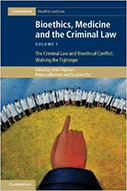Bioethics, Medicine, and the Criminal Law, Volume 1, The Criminal Law and Bioethical Conflict: Walking the Tightrope

Editors: Amel Alghrani, Rebecca Bennett, and Suzanne Ost
Publisher: Cambridge, UK; New York: Cambridge University Press, 2013. 290p.
Reviewer: David Orentlicher | November 2013
“The Criminal Law and Bioethical Conflict: Walking the Tightrope” provides an eclectic and rich collection of essays on bioethical controversies and the law.
The editors promise an exploration of “criminal law in theory and in practice” as it applies to dilemmas in bioethics, and most of the chapters deliver nicely. In one essay, for example, David Archard considers whether the criminal law should play a role in punishing medical malpractice and concludes that society should rely on the civil law to hold physicians accountable for their negligence. Similarly, in another essay, Amel Alghrani and Sarah Chan examine the need for criminal law sanctions as a supplement to other regulations of scientific research. By using the example of the misuse of reproductive or other patient tissues, Alghrani and Chan argue that criminal prohibitions can draw an appropriate balance between the interest in scientific freedom and the need for society to condemn serious misconduct.
Other chapters, however, essentially consider the role of the law in regulating the practice in question, rather than the role of criminal law versus civil law. For example, Robert Smith discusses the unusual phenomenon of “body integrity identity disorder” (BIID), in which a person requests amputation of a healthy limb, usually a leg. While a surgeon amputating a healthy limb could be prosecuted under English law for causing “grievous bodily harm,” Smith’s analysis focuses on the ethical and medical aspects of the issue. He concludes that the law should permit amputation of BIID in appropriate cases, and his logic would apply no differently to a civil prohibition than to a criminal ban.
The chapter on “cognitive chemical enhancements”—the use of drugs to help with attentiveness, memory and wakefulness—also focuses on regulation by law generally rather than by criminal law in particular. In that chapter, Nishat Hyder and John Harris argue in favor of broad individual access to drugs for purposes of cognitive enhancement (as opposed to using the same drugs to treat disease). In their view, the law should ensure that the drugs are tested for safety and quality when used for enhancement and that potential users be able to make properly informed decisions (e.g., through regulation of pharmaceutical advertising). However, the law should not prohibit use of drugs for cognitive enhancement, once safety and efficacy have been established. Hyder and Harris make important arguments, but their rejection of prohibitions would seem to apply just as much to civil prohibitions as to criminal prohibitions, and their acceptance of regulations for safety and quality would seem to include criminal as well as civil penalties for noncompliance.
This is not to say that these chapters are not valuable, only that they would fit just as well in any book on bioethics and law as in a book on bioethics and the criminal law.
As indicated, the book includes a range of essays that are diverse in both subject matter and in their level of abstraction. The chapters range from issues at the beginning of life to those at the end of life, from research to clinical practice. Some, such as the chapter on human dignity by Stephen Smith, are pitched at a more theoretical level, while others at a more practical level. For example, Marie Fox discusses the strict limits on abortion in Northern Ireland and considers which of the arguments for more permissive laws are likely to be most persuasive to legislators. She advises advocates to acknowledge the special nature of abortion compared to other medical procedures—after all, the life of a fetus is ended—and to emphasize the extent to which restrictions on abortion discriminate against women. In that regard, by telling the stories of women affected by abortion law, the harms of its limitations can be effectively conveyed.
To some extent, the book covers well-plowed ground. The chapters on physician-assisted suicide/euthanasia and abortion will be much more helpful to scholars not immersed in those topics. Still, experts often provide added value even for issues that have been carefully explored already. The debate between John Griffiths and John Keown on assisted suicide and euthanasia may draw on well-known arguments, but the two authors articulate the arguments especially effectively.
In addition, the book also examines questions that are not commonly considered in books on bioethics and law. Sara Fovargue discusses the role that the criminal law should play in regulating the transplantation of organs to humans from animals (xenotransplantation), a practice that one day may do much to address the serious shortage of transplantable organs. As mentioned, Robert Smith explains why a mentally competent adult should be able to choose surgical removal of a healthy leg or arm. And Suzanne Ost and Hazel Biggs mount an argument for criminal prohibitions in the context of “consensual” sexual activity between doctors and patients.
In a collection like this, it is inevitable that many arguments get insufficient attention. Fifteen or twenty pages are not enough to do justice to important questions in bioethics. Thus, for example, when Fovargue ultimately concludes that existing civil and criminal statutes in England and Wales do not provide sufficient authority for the state to deal with the communicable disease risks of xenotransplantation, her argument would be stronger if she better explained why she thinks that new legislation to address the risks should be criminal. Public health authorities wield a range of powers to ensure compliance with steps needed to prevent or treat communicable disease, including long-term commitment in hospitals. If other infectious diseases can be controlled with civil law, it is not clear why the state would need the option of prosecution and imprisonment to protect the public from infection with animal viruses. Indeed, as Fovargue acknowledges, invocation of the criminal law can have counterproductive effects on the public health if people are driven underground and avoid contact with the health care system.
The chapter by Ost and Biggs on sexual relationships between physician and patient also would be more satisfying with greater depth. Ost and Biggs recognize the complexities of the issue, and avoid the tendency of writers who can exaggerate the nature of the problem. However, their essay leaves the reader wondering exactly where they would draw their lines. They acknowledge the possibility, albeit rare in their view, of genuinely consensual sexual activity between physician and patient. Some particular examples of permissible relationships would be very helpful. Similarly, it also would be helpful to know where they would draw their line between inappropriate sexual activity that can be dealt with by professional regulation or other civil action and inappropriate sexual activity that rises to the level of criminal misconduct. They discuss the example of a female patient addicted to a painkiller who provided sexual favors to a physician in return for prescriptions, but other parts of their discussion suggest that they view less coercive behavior by a physician as crossing the civil-criminal line. For example, they refer to situations in which “the patient consents, but does so because the doctor’s more powerful position induces, entices, or causes her to be unable to say no” (p.113). When exactly does a physician’s inducement so cloud consent that seemingly consensual sexual relationships should elicit criminal charges?
David Gurnham’s intriguing essay on assumption of risk also would do well with additional analysis. Gurnham considers the criminal law’s differential treatment of consent to the risk of bodily harm from rough horseplay and consent to the risk of HIV transmission from sexual intercourse. As he observes, British courts are much more receptive to the defense of consent when a male is seriously injured from rough horseplay with other males than when a woman is exposed to HIV infection from sexual relations with a man. In Gurnham’s view, the differential treatment reflects on one hand a traditional social view that men should expect a good deal of rough and tumble in life while on the other hand a modern view that women should be protected from sexual violence. While there is much appeal to this explanation, it does not seem to explain another prominent sexual violence case discussed by Gurnham in which a man escaped prosecution with a consent defense. In that case, the man claimed that his female sexual partner had consented to taking the “date rape” drug and engaging in vigorous sexual activity and therefore had assumed the risk of the serious anorectal injury that she suffered. (The court would have rejected the consent defense if the man had admitted that he foresaw the danger to the woman.) One wonders whether the HIV infection cases are treated differently from the rough horseplay cases not because of views about violence against men or women but because of views about HIV disease. It would be better if Gurnham had the opportunity to develop his thesis in greater depth.
A few quibbles: Some of the authors assume familiarity with the court cases that they discuss, leaving the unfamiliar reader with uncertainty about the facts and legal holdings of the cases. In addition, some essays get too caught up in the details of existing British law, without indicating the extent to which the laws are idiosyncratic to the UK or similar to laws in other countries.
But these are small problems. All in all, if one is looking for thoughtful analyses on the role of law for a wide range of bioethical decisions, this book will be quite helpful.


